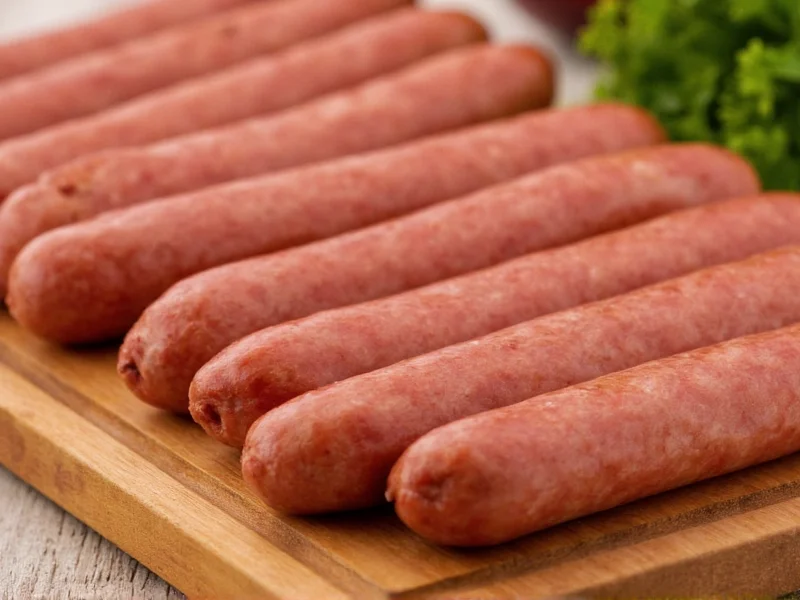Knowing exactly how can you tell when sausages are cooked is essential for both food safety and optimal taste. Undercooked sausages pose serious health risks from bacteria like salmonella and E. coli, while overcooked sausages become dry and unappetizing. This guide provides reliable methods to determine sausage doneness regardless of your cooking method or equipment.
Why Proper Sausage Cooking Temperature Matters
Food safety should always be your top priority when cooking sausages. Raw meat products can harbor harmful bacteria that only proper cooking temperatures eliminate. The USDA recommends specific internal temperatures to ensure sausages are safe to eat while maintaining their best texture and flavor.
Most Reliable Method: Using a Meat Thermometer
The single most accurate way to determine how to know when sausages are fully cooked is by using an instant-read meat thermometer. Here are the critical temperature thresholds:
| Sausage Type | Safe Internal Temperature | Visual Indicators |
|---|---|---|
| Pork, Beef, Lamb Sausages | 160°F (71°C) | No pink color, firm texture |
| Poultry Sausages | 165°F (74°C) | White or light brown, no pink |
| Pre-cooked Sausages | 140°F (60°C) | Heated through, golden brown |
Insert the thermometer into the thickest part of the sausage, avoiding contact with the cooking surface. Wait 10-15 seconds for an accurate reading. This method answers the common question of how to tell if sausage is cooked without thermometer with scientific precision.
Visual and Tactile Indicators When No Thermometer Is Available
If you don't have a meat thermometer, these visual and tactile signs can help determine what color should cooked sausage be and whether it's done:
- Color change: Properly cooked pork sausages should have no pink color remaining. Poultry sausages will turn white or light brown.
- Texture: Gently press the sausage with tongs or a fork. Cooked sausages will feel firm but not hard, with slight springiness.
- Juices: When pierced, the juices should run clear, not pink or red.
- Surface appearance: The exterior should be golden brown with crisp casing, not pale or gray.
Different Cooking Methods and Their Indicators
The method you use to cook sausages affects how you determine doneness. Here's how to tell how long to cook sausages on grill or other surfaces:
Pan-Frying
Cook sausages over medium heat for 15-20 minutes, turning regularly. They're done when golden brown on all sides and firm to the touch. The cooking oil should stop sizzling vigorously when the sausages are nearly done.
Grilling
On a grill, sausages typically take 12-18 minutes. Move them to indirect heat if they're browning too quickly before reaching proper internal temperature. Look for grill marks and slight charring on the casing as visual indicators of signs of undercooked sausage.
Baking
In the oven at 375°F (190°C), sausages need 20-25 minutes. They're done when the internal temperature reaches the safe threshold and the casing is crisp.
Common Mistakes to Avoid
Many home cooks make these errors when determining how to tell if sausage is cooked:
- Cutting to check: Slicing sausages releases juices, causing dryness. Use a thermometer instead.
- Relying solely on time: Cooking times vary based on sausage size and heat intensity.
- Ignoring resting time: Let sausages rest for 3-5 minutes after cooking; internal temperature continues to rise slightly.
- Mistaking browning for doneness: Sausages can brown quickly while remaining undercooked inside.
Special Considerations for Different Sausage Types
Understanding how can you tell when sausages are cooked varies by sausage variety:
- Italian sausages: Often contain fennel and garlic; check for firm texture rather than color alone.
- Bratwurst: Traditionally parboiled first; final cooking should reach 160°F (71°C).
- Chicken or turkey sausages: Require higher temperature (165°F/74°C) and may appear done before reaching safe temperature.
- Veggie sausages: Follow package instructions as they don't require the same temperatures as meat sausages.
Food Safety Guidelines
Always follow these safety practices when cooking sausages:
- Never serve sausages that still have pink coloring in the center (except for certain cured sausages like salami).
- Wash hands and surfaces that contact raw sausage to prevent cross-contamination.
- Store leftovers within two hours of cooking at 40°F (4°C) or below.
- Reheat leftovers to 165°F (74°C) before consuming.
Conclusion
Mastering how to determine when sausages are properly cooked ensures both safety and delicious results. While visual cues provide helpful guidance, an instant-read thermometer remains the most reliable method to answer how to know when sausages are fully cooked. By understanding the specific temperature requirements for different sausage types and recognizing the visual indicators of proper doneness, you'll consistently achieve perfectly cooked sausages every time.
Frequently Asked Questions
Can you tell if sausages are cooked by cutting them open?
While cutting can show color, it's not recommended as it releases juices and can make sausages dry. A meat thermometer is more reliable and doesn't compromise the sausage's moisture.
What happens if you eat slightly undercooked sausage?
Consuming undercooked sausage can expose you to harmful bacteria like salmonella, E. coli, or listeria, potentially causing food poisoning with symptoms including nausea, vomiting, diarrhea, and fever.
How long should sausages rest after cooking?
Let sausages rest for 3-5 minutes after cooking. This allows juices to redistribute throughout the meat and the internal temperature to stabilize, typically rising 2-5 degrees during this time.
Why do some sausages remain pink even when fully cooked?
Certain sausages with nitrites or natural curing agents may retain a pink color even when fully cooked. Always verify doneness with a thermometer rather than relying solely on color.
Can you overcook sausages?
Yes, overcooking sausages beyond 170°F (77°C) causes them to become dry, tough, and lose their flavor. The ideal temperature range is 160-165°F (71-74°C) depending on the meat type.











 浙公网安备
33010002000092号
浙公网安备
33010002000092号 浙B2-20120091-4
浙B2-20120091-4